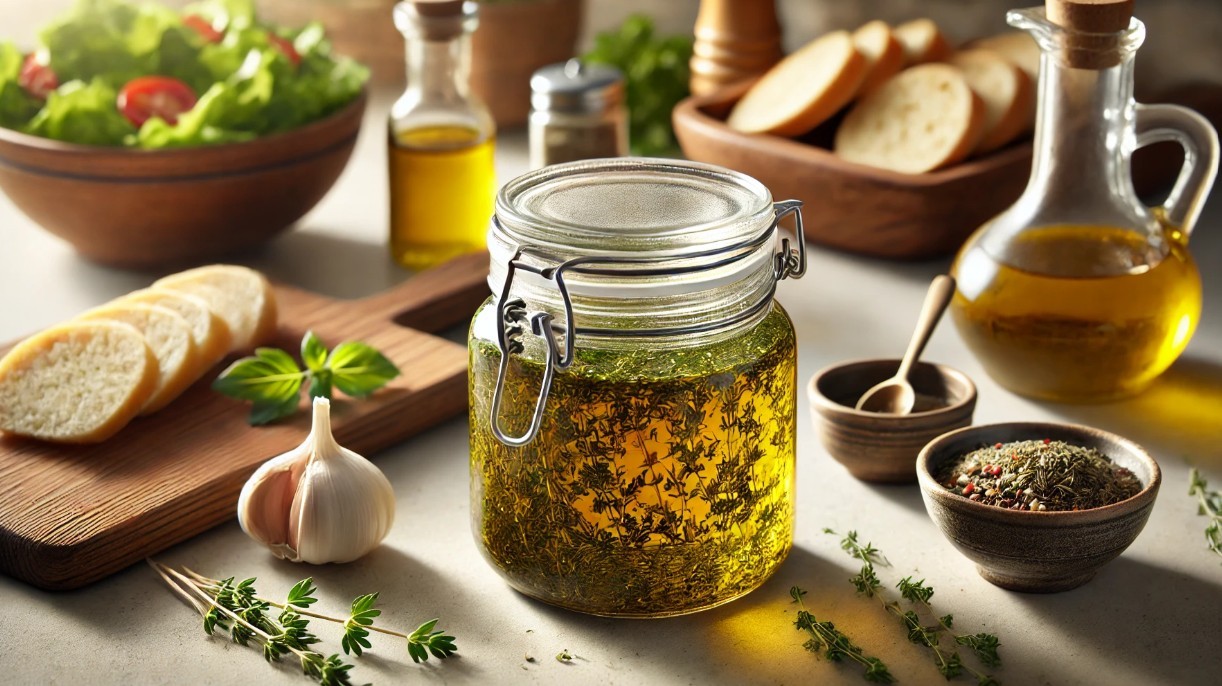Did you know that the secret to a truly satisfying salad isn’t just the fresh vegetables but the dressing? A well-crafted vinaigrette can transform a simple dish into something extraordinary.
With just a handful of ingredients and a few easy steps, you can create restaurant-quality vinaigrettes at home.
Vinaigrettes aren’t just for salads; they can add flavour and sophistication to roasted vegetables, marinades, and even sandwiches.
In this blog, you’ll learn everything about vinaigrette recipe, from their history to recipes, variations, and nutritional benefits. Let’s dive into the world of this versatile dressing.
What is a Vinaigrette?
A vinaigrette is a classic salad dressing made by emulsifying oil with an acidic component, such as vinegar or citrus juice. This dressing has its roots in French cuisine, where it’s cherished for its simplicity and versatility.
The secret to a perfect vinaigrette lies in emulsification, the process of blending oil and vinegar into a harmonious mixture. While a traditional vinaigrette is oil-heavy, modern recipes often incorporate creative twists with herbs, spices, and sweeteners for added flair.
Vinaigrette Ingredients
Here’s a breakdown of the key ingredients you’ll need to craft the perfect vinaigrette:
| Ingredient | Quantity | Purpose |
| Olive oil (extra virgin) | 3 tablespoons | Forms the base; adds richness and smoothness |
| Vinegar (red wine, balsamic, or apple cider) | 1 tablespoon | Provides acidity and balance to the oil |
| Dijon mustard | 1 teaspoon | Acts as an emulsifier; adds depth of flavour |
| Salt | 1/4 teaspoon | Enhances overall taste |
| Black pepper | 1/4 teaspoon | Adds a touch of spice and warmth |
| Optional: Honey or maple syrup | 1 teaspoon | Adds sweetness to balance tangy and bitter notes |
| Optional: Garlic (minced or crushed) | 1 clove | Introduces a pungent, savoury element |
| Optional: Fresh herbs (basil, parsley) | 1 tablespoon (chopped) | Enhances aroma and adds freshness |
Vinaigrette Instructions
Measure Your Ingredients: Use the standard ratio of 3:1 oil to vinegar for a balanced flavour. Adjust according to taste.

Combine: Add all ingredients to a mixing bowl or jar. If using a jar, make sure it has a tight-fitting lid.

Emulsify: Whisk vigorously in a bowl or shake the jar until the oil and vinegar blend into a creamy consistency.

Adjust Flavours: Taste the mixture and tweak as needed—add more vinegar for tanginess, honey for sweetness, or mustard for a richer texture.

Serve or Store: Use immediately, or refrigerate in an airtight container for up to a week. Shake before serving if stored.

Vinaigrette Serving Suggestions
Vinaigrettes are far more versatile than you might think. While their primary use is as a salad dressing, they can elevate a wide range of dishes. Here are some creative ways to incorporate vinaigrettes into your cooking:
Classic Salads
- A good vinaigrette is a must-have for salads, whether it’s a simple mix of greens or a hearty combination of roasted vegetables, nuts, and cheese.
- Pair a tangy balsamic vinaigrette with a spinach salad, or use a zesty lemon vinaigrette for a light summer salad with berries and goat cheese.
Grain Bowls and Pasta Salads
- Vinaigrettes are perfect for adding flavour to grain bowls made with quinoa, bulgur, or farro.
- Toss them with cooked grains, fresh vegetables, and protein for a nutritious meal.
- For pasta salads, a herb-infused vinaigrette can bring the dish to life by adding freshness and zest.
Roasted Vegetables
- Drizzle a vinaigrette over warm roasted vegetables like Brussels sprouts, carrots, or sweet potatoes.
- The tanginess enhances the natural sweetness of the roasted veggies, creating a delicious side dish or vegetarian main course.
Marinades for Proteins
- Use vinaigrettes as marinades for chicken, beef, fish, or tofu.
- The acidity from the vinegar tenderises the meat, while the oil and spices infuse it with flavour.
- For example, a honey mustard vinaigrette works beautifully for grilled chicken, while a lemon vinaigrette is ideal for seafood.
Sandwiches and Wraps
Replace heavy mayonnaise or creamy spreads with a light vinaigrette. Drizzle it over sandwich fillings or toss it with the greens before adding them to the sandwich. This adds a fresh and tangy element to every bite.
- Dips and Spreads: Mix a vinaigrette with yoghurt or cream cheese to create a light and flavourful dip for vegetables, crackers, or breadsticks.
- Soups and Stews: Add a small splash of vinaigrette to hearty soups or stews just before serving. This brightens up the dish and adds a layer of complexity. For example, a drizzle of balsamic vinaigrette can elevate a bowl of creamy tomato soup.
- Pizza and Flatbreads: Use vinaigrette as a finishing drizzle on pizzas or flatbreads topped with arugula, prosciutto, or roasted vegetables. It adds a gourmet touch that complements the dish.
Vinaigrette Variations

Once you master the basic vinaigrette, the possibilities are endless. Here are detailed recipes and suggestions for creative variations:
Lemon Vinaigrette
- Ingredients: Olive oil, lemon juice, Dijon mustard, honey, salt, and pepper.
- How to Use?: This bright and zesty dressing pairs beautifully with grilled seafood, fresh salads, or steamed asparagus. It’s also great as a marinade for chicken.
Balsamic Vinaigrette
- Ingredients: Balsamic vinegar, olive oil, Dijon mustard, garlic, salt, and pepper.
- How to Use?: Perfect for drizzling over caprese salads with fresh mozzarella and tomatoes. It also works well with roasted vegetables, steak salads, or even as a glaze for grilled meats.
Honey Mustard Vinaigrette
- Ingredients: Olive oil, apple cider vinegar, honey, Dijon mustard, and garlic.
- How to Use?: This sweet and tangy variation is excellent for dipping chicken tenders, dressing hearty kale salads, or as a spread for sandwiches and wraps.
Herb-Infused Vinaigrette
- Ingredients: Olive oil, red wine vinegar, fresh parsley, basil, garlic, and chilli flakes.
- How to Use?: Toss this aromatic vinaigrette with pasta salads, grilled vegetables, or as a dipping sauce for crusty bread.
Raspberry Vinaigrette
- Ingredients: Raspberry puree, red wine vinegar, olive oil, honey, and a pinch of salt.
- How to Use?: Ideal for fruit salads or spinach salads with nuts and goat cheese. Its fruity profile also pairs well with grilled chicken or pork.
Creamy Avocado Vinaigrette
- Ingredients: Avocado, olive oil, lime juice, garlic, and a touch of Greek yoghurt.
- How to Use?: This creamy variation is perfect for topping taco salads, grain bowls, or using as a dipping sauce for roasted sweet potato fries.
Asian-Inspired Sesame Vinaigrette
- Ingredients: Sesame oil, rice vinegar, soy sauce, ginger, honey, and olive oil.
- How to Use?: Great for Asian noodle salads, slaws, or as a marinade for grilled shrimp or tofu.
Orange-Ginger Vinaigrette
- Ingredients: Orange juice, ginger, olive oil, white wine vinegar, honey, and a pinch of chilli flakes.
- How to Use?: This sweet and spicy vinaigrette is perfect for drizzling over roasted root vegetables or mixing into a quinoa salad.
Maple Dijon Vinaigrette
- Ingredients: Maple syrup, Dijon mustard, apple cider vinegar, olive oil, salt, and pepper.
- How to Use?: Adds a subtle sweetness to autumn-inspired salads with apples, pecans, and spinach.
Tahini Vinaigrette
- Ingredients: Tahini, lemon juice, olive oil, garlic, and a touch of water to thin.
- How to Use?: Excellent for Mediterranean-inspired salads, roasted cauliflower, or as a dipping sauce for pita bread.
Vinaigrette Nutrition Details
Here’s the nutritional breakdown for a basic vinaigrette recipe (per tablespoon):
| Nutrient | Amount |
| Calories | 100 kcal |
| Total Fat | 11 g |
| Saturated Fat | 1.5 g |
| Sodium | 100 mg |
| Carbohydrates | 0.5 g |
| Protein | 0 g |
Tips for a Healthier Vinaigrette
- Reduce the oil for a lighter version.
- Substitute sugar or honey with stevia or maple syrup for a healthier sweetener.
- Use yoghurt or avocado for a creamy, low-fat alternative.
Conclusion
Mastering a homemade vinaigrette is a simple yet impactful way to elevate your culinary skills.
Whether you stick to the classic recipe or try creative variations, a good vinaigrette can add depth, flavour, and excitement to your meals.
By experimenting with ingredients and ratios, you can create a dressing that suits your taste and dietary needs.
Take the plunge into the world of vinaigrettes today and enjoy the satisfaction of crafting your own signature dressing!
Frequently Asked Questions (FAQs)
How do I fix a broken vinaigrette?
Add a teaspoon of mustard or whisk in water to help re-emulsify.
Can I make vinaigrette ahead of time?
Yes, store in an airtight container in the fridge for up to a week.
What’s the best oil for vinaigrette?
Extra virgin olive oil is preferred, but avocado or walnut oil works well for unique flavours.
Can I make vinaigrette without mustard?
Yes, but mustard helps emulsify. You can use mayonnaise or yoghurt as a substitute.
How do I make vinaigrette creamy?
Blend in yoghurt, mayonnaise, or avocado for a creamy texture.
Is vinaigrette suitable for vegans?
Most vinaigrettes are vegan unless they contain honey. Substitute honey with agave syrup for a vegan option.
How long does homemade vinaigrette last?
It can last about a week in the fridge if stored properly in an airtight container.

Vinaigrette Recipe
Ingredients
- 3 tablespoons Olive oil
- 1 tablespoon Vinegar ed wine, balsamic, or apple cider
- 1 tablespoon Dijon mustard
- 1/4 tablespoon Salt
- 1/4 teaspoon Black pepper
- 1 tablespoon Honey or maple syrup
- 1 tablespoon Garlic, minced or crushed clove
- 1 tablespoon basil, parsley
Instructions
- Use the standard ratio of 3:1 oil to vinegar for a balanced flavour. Adjust according to taste.
- Add all ingredients to a mixing bowl or jar. If using a jar, make sure it has a tight-fitting lid.
- Whisk vigorously in a bowl or shake the jar until the oil and vinegar blend into a creamy consistency.
- Taste the mixture and tweak as needed—add more vinegar for tanginess, honey for sweetness, or mustard for a richer texture.
- Use immediately, or refrigerate in an airtight container for up to a week. Shake before serving if stored.









